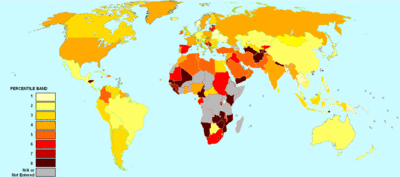Introduction to principles of macroeconomics/Types of unemployment
Frictional unemployment, which is the least severe of the three types, occurs as a result of individuals' movements between jobs. Structural unemployment, which is the most severe of the three types, typically requires workers to seek retraining or additional education as a consequence of structural changes in the economy. Cyclical unemployment is the result of downturns in the business cycle, economic contractions, or recessions.
Unemployment: Types, kinds, and quantities
As you saw in the previous reading, unemployment can be measured in many ways. This reading will provide a few additional measures of unemployment that were not discussed in the textbook. In the United States, we use six measures of unemployment. The table and numbers in this resource come from the Bureau of Labor Statistics, the federal agency that monitors and reports on unemployment.
In September 2015, there were 156.61 million people in the civilian labor force. The civilian labor force (CLF) is comprised of all US citizens ages 16 years and up who are not excluded from the labor force. People who are excluded from the labor force include those in military service; retired persons; persons attending a post-secondary education program full time; and incarcerated persons. These categories of people are not available for work. Discouraged workers, individuals who are not seeking jobs, are also excluded from this measure.
The table below gives the actual numbers of people that fall into various measures and estimates of unemployment.
Table. Alternative Measures of Labor Underutilization Measure, from http://www.bls.gov/news.release/empsit.t15.htm
| % | Estimated number (in millions) | |
| U-1 Persons unemployed 15 weeks or longer, as a percent of the civilian labor force | 2.1 | 3.289 |
| U-2 Job losers and persons who completed temporary jobs, as a percent of the civilian labor force | 2.5 | 3.915 |
| U-3 Total unemployed, as a percent of the civilian labor force (official unemployment rate) | 5.1 | 7.987 |
| U-4 Total unemployed plus discouraged workers, as a percent of the civilian labor force plus discouraged workers | 5.4 | 8.457 |
| U-5 Total unemployed, plus discouraged workers, plus all other persons marginally attached to the labor force, as a percent of the civilian labor force plus all persons marginally attached to the labor force | 6.2 | 9.710 |
| U-6 Total unemployed, plus all persons marginally attached to the labor force, plus total employed part time for economic reasons, as a percent of the civilian labor force plus all persons marginally attached to the labor force | 10.0 | 15.661 |
Note: Persons who are marginally attached to the labor force are those who are neither working currently, nor looking for work, but who want and are available for a job and have looked for work sometime in the past 12 months. Discouraged workers, a subset of the marginally attached, have given a job-market related reason for not currently looking for work. Persons employed part time for economic reasons are those who want and are available for full-time work but have had to settle for a part-time schedule. Updated population controls are introduced annually with the release of January data.
As you can see, portraying unemployment is all about the definition you use. To recap:
- U1 representes all people in the CLF that are actively seeking employment and have been doing so for 15 or more weeks. This measure exclude recently unemployed people.
- U2 is made up of people in the CLF that have recently lost a job (involuntarily) or have finished a temporary job in the reporting period. (People in the U2 category are "job losers.")
Note: If U1 and U2 are added, the sum provides an indicator of total unemployment, but with some omissions. There is an international convention from the ILO (International Labor Organization, a part of the United Nations) on how to measure unemployment. The US and all OECD countries follow it, allowing for international comparisons of unemployment. U3, then, is derived from a comprehensive household and employer survey whose parameters are set by the ILO.
- U3 measures the “official” rate of unemployment and is the statistic that gets reported and discussed the most. It is developed through a comprehensive survey of businesses and household and government records. U3 is that proportion of the civilian labor force that is unemployed but actively seeking employment.
- U4 is U3 adjusted for discouraged workers. Discouraged workers are classified as unemployed even though they are not actively seeking employment.
- U5 includes persons who are "marginally attached" to the workforce as a part of the unemployed. The marginally attached are people who are not actively seeking work but would like to have a job if one were available. This group includes "discouraged workers" but many others.
- U6 is the final measure of unemployment. U6 includes all of those in the U5 category plus people underemployed persons. Underemployed persons work in part time jobs but would prefer to have a full time job. Alternatively, the underemployed may have jobs that are poorly suited to their skill level and education and seek employment that pays better and is better reflective of their experience and capability.
When you're done, summarize your key take-away from this reading in a WeNotes Post.
